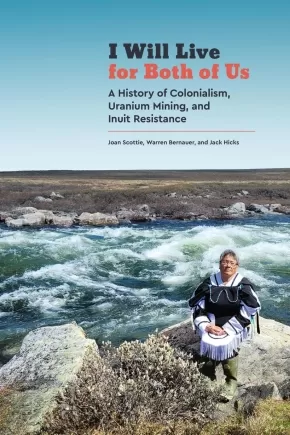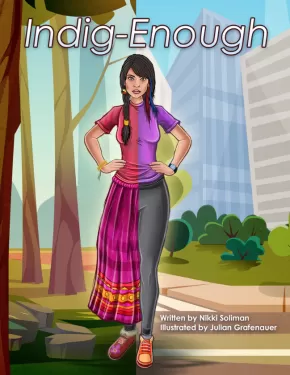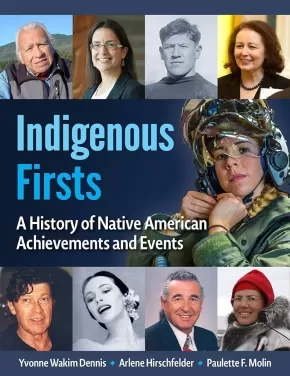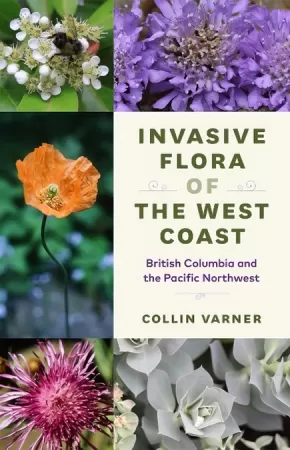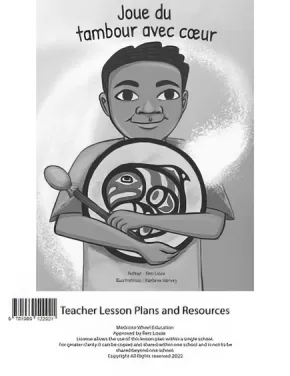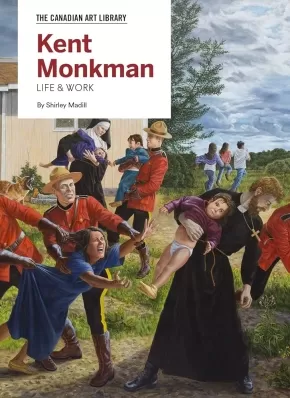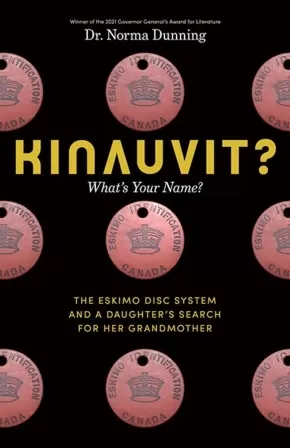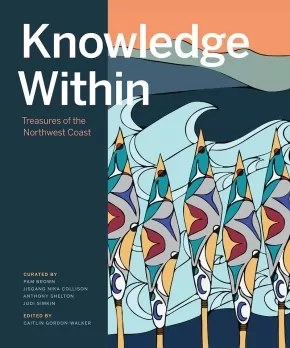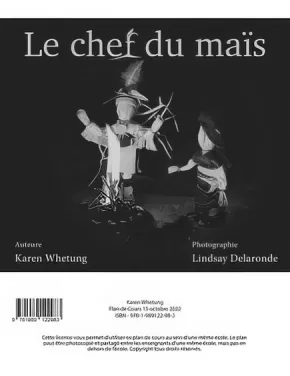
Books
571
-
585
of
1928 Results;
Sort By
Go To
of 129
Heartbeat of the Earth: A Handbook on Connecting Children to Nature through Indigenous Teachings
$47.75
Artists:
Format:
Paperback
Text Content Territories:
Indigenous Canadian;
ISBN / Barcode: 9781778258701
Synopsis:
Synopsis:
Nature is a place to both play and learn. The physical self is moving and active, the mental self is thinking and questioning, the emotional self is feeling and experiencing, and the spiritual self is connecting and thankful. We see what we have been taught to see. We love and respect our natural surroundings when we see ourselves as belonging to that community. This resource leads readers on a rich learning journey as they deepen their connections to nature and culture.
The activities inside instill traditional teachings of respect, honour, resourcefulness, and humility in children. This handbook is intended to inspire parents, caregivers, and educators to provide children with meaningful outdoor experiences interwoven with traditional indigenous knowledge.
Educator Information
For use with children.
Table of Contents
Introduction
The Power of Ceremony
- Introduction
- Ceremony and Daily Life
- Sunrise Ceremony
- Nature Picnic
- Sharing
- Navajo Forgiveness Ceremony
- Smudging Ceremony
Mindfulness: Meditation of Gratitude
- Introduction
- Gratitude
- Silent Study
- Sensory Wake-Up
- Walking Meditation
- Guided Meditation
- Nature Meditation
- Traditional Prayers
We Are All Related
- Honouring the Plants, Earth and Water
- Medicine Wheel Teachings in Nature
- Water is Life
- Find the Rock Game
- Adopt a Tree
- Read a Tree
- Earthing
- Build a Nature Structure
Swimmers, Walkers and Fliers
- The Animal People
- Walk Like the Animal People
- Tracking
Indigenous Games
- Introduction
- Blindfold Detective
- Stalk the Drum
- Fire Keeper
- Deer Cliff Arrow
- Hunter
- Run and Scream
- Metis Map-Making
Conclusion
Additional Information
84 pages | 9.00" x 7.00" | Paperback
Horses in the Sand: A Memoir
$22.95
Format:
Paperback
Text Content Territories:
Indigenous Canadian; Métis;
Reading Level: N/A
ISBN / Barcode: 9781771338493
Synopsis:
Synopsis:
Horses in the Sand is a collection of stories that document a queer woman's journey from her sparse beginnings as a child to becoming a tradeswoman, teacher, and artist. With courage, humour, and frank honesty, the stories describe what it was like to grow up as a girl who was starkly different from "normal" and how "coming out" became a lifelong process of self-acceptance and changing identities. The stories also speak to the difficulties in participating in and maintaining healthy adult relationships when childhood beginnings are rooted in violence and trauma, and end with a triumphant account of fulfilling a long-time dream of buying land and building a home with her own hands. Ultimately, the memoir is a celebration of making art, telling stories, and of finding her birth father, a family of half-siblings, and an Indigenous community whose presence she had always felt, but never knew she belonged to.
Additional Information
260 pages | 5.50" x 8.25" | Paperback
I Will Live for Both of Us: A History of Colonialism, Uranium Mining, and Inuit Resistance
$24.95
Format:
Paperback
Text Content Territories:
Indigenous Canadian; Inuit;
Grade Levels: 12; University/College;
ISBN / Barcode: 9780887552656
Synopsis:
Synopsis:
Born at a traditional Inuit camp in what is now Nunavut, Joan Scottie has spent decades protecting the Inuit hunting way of life, most famously with her long battle against the uranium mining industry. Twice, Scottie and her community of Baker Lake successfully stopped a proposed uranium mine. Working with geographer Warren Bernauer and social scientist Jack Hicks, Scottie here tells the history of her community’s decades-long fight against uranium mining.
Scottie's I Will Live for Both of Us is a reflection on recent political and environmental history and a call for a future in which Inuit traditional laws and values are respected and upheld. Drawing on Scottie’s rich and storied life, together with document research by Bernauer and Hicks, their book brings the perspective of a hunter, Elder, grandmother, and community organizer to bear on important political developments and conflicts in the Canadian Arctic since the Second World War.
In addition to telling the story of her community’s struggle against the uranium industry, I Will Live for Both of Us discusses gender relations in traditional Inuit camps, the emotional dimensions of colonial oppression, Inuit experiences with residential schools, the politics of gold mining, and Inuit traditional laws regarding the land and animals. A collaboration between three committed activists, I Will Live for Both of Us provides key insights into Inuit history, Indigenous politics, resource management, and the nuclear industry.
Reviews
“I Will Live for Both of Us is the first-hand account of an incredible woman’s resistance to uranium mining in her region specifically, but it is also a detailed description of the history of colonialism in the Kivalliq region, and the past and present structures that perpetuate colonialism. It shines a light on the critical activism that has been happening in this region over the course of decades.” — Willow Scobie
"I Will Live for Both of Us offers a unique and important contribution to our understanding of the history and contemporary debates around mining in the Canadian North. It foregrounds the voice and activism of an Inuk woman, Joan Scottie, and documents her long struggle against the incursions of uranium mining in the Kivalliq Region of Nunavut. Written accessibly it will appeal to readers interested in the North, Indigenous issues, and industrial development.” — Arn Keeling
Educator Information
Table of Contents
Ch 1: Growing Up on the Land
Ch 2: Qallunaat, Moving to Town, and Going to School
Ch 3: Uranium Exploration, Petitions, and a Court Case
Ch 4: Kiggavik Round One, the Urangesellschaft Proposal
Ch 5: The Nunavut Agreement and Gold Mining Near Baker Lake
Ch 6: Uranium Policy in Nunavut
Ch 7: Kiggavik Round Two, the AREVA Proposal
Ch 8: Protecting the Land and the Caribou
Conclusion
Additional Information
264 pages | 6.00" x 9.00" | Index, Bibliography | Paperback
Indig-Enough
$22.99
Artists:
Format:
Paperback
ISBN / Barcode: 9781990297427
Synopsis:
Synopsis:
Indig-Enough is a rhyming story that captures the author's journey in navigating and embracing her indigeneity, honouring her roots, and walking tall towards the future. This book can help guide young people in the exploration and the awareness of identity and intersectionality which can sometimes make it difficult to fit in and find their place.
Educator Information
Recommended by publisher for grades 3 to 7.
Additional Information
16 Pages
Indigenous Firsts: A History of Native American Achievements and Events
$50.95
Format:
Paperback
Text Content Territories:
Indigenous American; Alaska Native; Native American;
ISBN / Barcode: 9781578597123
Synopsis:
Synopsis:
A celebration of achievement, accomplishments, and courage!
Native American Medal of Honor recipients, Heisman Trophy recipients, U.S. Olympians, a U.S. vice president, Congressional representatives, NASA astronauts, Pulitzer Prize recipients, U.S. poet laureates, Oscar winners, and more. The first Native magician, all-Native comedy show, architects, attorneys, bloggers, chefs, cartoonists, psychologists, religious leaders, filmmakers, educators, physicians, code talkers, and inventors. Luminaries like Jim Thorpe, King Kamehameha, Debra Haaland, and Will Rogers, along with less familiar notables such as Native Hawaiian language professor and radio host Larry Lindsey Kimura and Cree/Mohawk forensic pathologist Dr. Kona Williams. Their stories plus the stories of 2000 people, events and places are presented in Indigenous Firsts: A History of Native American Achievements and Events, including:
- Suzanne Van Cooten, Ph.D., Chickasaw Nation, the first Native female meteorologist in the country
- Caleb Cheeshahteaumuck, Wampanoag from Martha’s Vineyard, graduate of Harvard College in 1665
- Debra Haaland, the Pueblo of Laguna, U.S. Congresswoman and Secretary of the Interior
- Sam Campos, the Native Hawaiian who developed the Hawaiian superhero Pineapple Man
- Thomas L. Sloan, Omaha, was the first Native American to argue a case before the U.S. Supreme Court
- William R. Pogue, Choctaw, astronaut
- Johnston Murray, Chickasaw, the first person of Native American descent to be elected governor in the United States, holding the office in Oklahoma from 1951 to 1955
- The Cherokee Phoenix published its first edition February 21, 1828, making it the first tribal newspaper in North America and the first to be published in an Indigenous language
- The National Native American Honor Society was founded by acclaimed geneticist Dr. Frank C. Dukepoo , the first Hopi to earn a Ph.D.
- Louis Sockalexis, Penobscot, became the first Native American in the National Baseball League in 1897 as an outfielder with the Cleveland Spiders
- Jock Soto, Navajo/Puerto Rican, the youngest-ever man to be the principal dancer with the New York City Ballet
- The Seminole Tribe of Florida was the first Nation to own and operate an airplane manufacturing company
- Warrior's Circle of Honor, the National Native American Veterans Memorial in Washington, DC, on the grounds of the Smithsonian’s National Museum of the American Indian
- The Iolani Palace, constructed 1879–1882, the home of the Hawaiian royal family in Honolulu
- Loriene Roy, Anishinaabe, White Earth Nation, professor at the University of Texas at Austin’s School of Information, former president of the American Library Association
- Ben Nighthorse Campbell, Northern Cheyenne, U.S. representative and U.S. senator from Colorado
- Hanay Geiogamah, Kiowa /Delaware, founded the American Indian Theatre Ensemble
- Gerald Vizenor, White Earth Nation, writer, literary critic, and journalist for the Minneapolis Tribune
- Ely S. Parker (Hasanoanda, later Donehogawa), Tonawanda Seneca, lieutenant colonel in the Union Army, serving as General Ulysses S. Grant’s military secretary
- Fritz Scholder, Luiseno, painter inducted into the California Hall of Fame
- The Native American Women Warriors, the first all Native American female color guard
- Lori Arviso Alvord, the first Navajo woman to become a board-certified surgeon
- Kay “Kaibah” C. Bennett, Navajo, teacher, author, and the first woman to run for the presidency of the Navajo Nation
- Sandra Sunrising Osawa, Makah Indian Nation, the first Native American to have a series on commercial television
- The Choctaw people’s 1847 donation to aid the Irish people suffering from the great famine
- Otakuye Conroy-Ben, Oglala Lakota, first to earn an environmental engineering Ph.D. at the University of Arizona
- Diane J. Willis, Kiowa, former President of the Society of Pediatric Psychology and founding editor of the Journal of Pediatric Psychology
- Shelly Niro, Mohawk, winner of Canada’s top photography prize, the Scotiabank Photography Award
- Loren Leman, Alutiiq/Russian-Polish, was the first Alaska Native elected lieutenant governor
- Kim TallBear, Sisseton-Wahpeton Oyate, the first recipient of the Canada Research Chair in Indigenous Peoples, Technoscience, and Environment
- Carissa Moore, Native Hawaiian, won the Gold Medal in Surfing at the 2020 Tokyo Olympics
- Will Rogers, Cherokee, actor, performer, humorist was named the first honorary mayor of Beverly Hills
Foods of the Southwest Indian Nations by Lois Ellen Frank, Kiowa, was the first Native American cookbook to win the James Beard Award - Diane Humetewa, Hopi, nominated by President Barack Obama, became the first Native American woman to serve as a federal judge
- Susie Walking Bear Yellowtail, Crow, the first Native American nurse to be inducted into the American Nursing Association Hall of Fame
Indigenous Firsts honors the ongoing and rich history of personal victories and triumphs, and with more than 200 photos and illustrations, this information-rich book also includes a helpful bibliography and an extensive index, adding to its usefulness. This vital collection will appeal to anyone interested in America’s amazing history and its resilient and skilled Indigenous people.
Additional Information
496 pages | 7.19" x 9.18" | Paperback
Inuunira: My Story of Survival
$19.95
Artists:
Format:
Hardcover
Text Content Territories:
Indigenous Canadian; Inuit;
ISBN / Barcode: 9781772274301
Synopsis:
Synopsis:
In this harrowing survival story, Brian Koonoo takes off on a hunting trip in Canada’s Arctic. After his snowmobile breaks down, his GPS loses signal, and his camping fuel runs low, he is left alone to survive for seven days. Inuunira is an Inuktitut term that means "how I'm alive," and this account shows exactly how Brian managed to stay alive. He experiences close encounters with planes, blizzards, and hunger, all while much of his gear is lost. Walking 60 kilometres in search of safety, he uses the knowledge his father and Elders taught him—modern and traditional means of navigation, finding water, making shelters, and keeping his spirits up—to continue on. With photos, illustrations, and diagrams throughout, readers are sure to be inspired by this story of strong will and hope.
Additional Information
37 pages | 6.75" x 9.50" | Hardcover
Invasive Flora of the West Coast: British Columbia and the Pacific Northwest
$24.95
Format:
Paperback
ISBN / Barcode: 9781772034134
Synopsis:
Synopsis:
A compact, full-colour field guide to the growing number of invasive plant species spreading across coastal BC and the Pacific Northwest, highlighting their hazards and uses.
The spread of invasive plant species is a growing concern across the coastal Pacific Northwest. Invasive plants compete for space with native plants, alter the natural habitat, and even interfere with the diets of local wildlife. Hundreds of these species are so commonly seen in our backyards, forests, and roadsides, that many people do not even realize that these plants are not native to this region.
Designed for amateur naturalists, gardeners, and foragers, Invasive Flora of the West Coast is a clear, concise, full-colour guide to identifying and demystifying more than 170 invasive plant species in our midst, from Evening primrose to Scotch broom. Featuring colour photography, origin and etymology, safety tips and warnings, as well as historical uses, this book is practical, user-friendly, and portable for easy, on-the-go identification.
Reviews
“Varner’s latest contribution reveals the astonishing diversity of plants, vines, shrubs, and trees that crossed continents and oceans to take root in our backyard. Like the teeming collection of uninvited guests it describes, this guide would be appalling if it weren’t so wondrous. A concise and vivid gem.”—Arno Kopecky, author of The Environmentalist's Dilemma
“Collin Varner has ticked yet another much-needed field-guide box with his latest book. This tidy volume describes more than 170 of the region's bad horticultural actors with concise descriptions and plenty of fascinating cultural tidbits, all illustrated and many with Varner's own excellent photographs.”—Douglas Justice, Associate Director, Horticulture & Collections, UBC Botanical Garden
“Invasive plants are the second greatest threat to biodiversity and are often found in and around the communities in which we live and play. This accessible guide offers readers a solid resource, enabling all of us to be more self-reliant in confidently identifying plants causing some of the greatest damage to our gardens, backyards, natural areas, and sensitive farm habitats. This book belongs on the shelves of everyone who enjoys our natural spaces, and who wants to ensure healthy landscapes for generations to come.”—Gail Wallin, Executive Director, Invasive Species Council of BC"
Additional Information
224 pages | Paperback
Joue du tambour avec coeur plan de cours (LP)
$7.99
Format:
Paperback
Text Content Territories:
Indigenous Canadian; First Nations; Nuu-chah-nulth (Nootka);
ISBN / Barcode: 9781989122921
Synopsis:
Synopsis:
Plan de cours de l'enseignant qui accompagne le livre Joue du tambour avec coeur. Quand sa mère lui donne un tambour fait à la main en cadeau, Ren apprend les enseignements du tambour qu’on lui transmet par le fait même. Il découvre que, grâce à ce tambour spécial, il peut créer des liens avec sa culture et reprendre confiance en sa voix pour partager avec joie les chansons traditionnelles de sa nation, la Nation Nuu-chah-nulth.
Educator Information
Find the student resource here: Joue du tambour avec coeur
This resource is available in English: Drum from the Heart Teacher Lesson Plan
Additional Information
14 pages | 8.50" x 11.00" | Paper Packet
Kaandossiwin: How We Come to Know: Indigenous Re-Search Methodologies - 2nd Edition
$32.00
Format:
Paperback
Text Content Territories:
Indigenous Canadian; First Nations; Anishinaabeg;
Grade Levels: University/College;
ISBN / Barcode: 9781773635170
Synopsis:
Synopsis:
Indigenous methodologies have been silenced and obscured by the Western scientific means of knowledge production. In a challenge to this colonialist rejection of Indigenous knowledge, Anishinaabe re-searcher Kathleen Absolon describes how Indigenous re-searchers re-theorize and re-create methodologies. Indigenous knowledge resurgence is being informed by taking a second look at how re-search is grounded. Absolon consciously adds an emphasis on re with a hyphen as a process of recovery of Kaandossiwin and Indigenous re-search. Understanding Indigenous methodologies as guided by Indigenous paradigms, worldviews, principles, processes and contexts, Absolon argues that they are wholistic, relational, inter-relational and interdependent with Indigenous philosophies, beliefs and ways of life. In exploring the ways Indigenous re-searchers use Indigenous methodologies within mainstream academia, Kaandossiwin renders these methods visible and helps to guard other ways of knowing from colonial repression. This second edition features the author’s reflections on her decade of re-search and teaching experience since the last edition, celebrating the most common student questions, concerns, and revelations.
Educator Information
Table of Contents
Part One: Preparation For The Search
1) An Introduction to Preparing for Re-Search: Having Tea & Bannock
Re-storying and restoring location
Restoring self: Locating My Self
Decolonizing and Indigenizing My Re-search
Language and Terminology
Chapter Outlines
2) Indigenous Re-Search: Past, Present and Future
Indigenous Peoples’ Cultural History and Research
Oral Traditions and Narrative
Indigenous Knowledge Resurgence: Shifting Landscapes
Trailblazers: Re-searchers and their Searches
3) Colonial Research Trauma My Own Search: A Journey of Making Meaning
4) The Search Trail and Pathway
Part Two: Wholistic Re-Search Methodologies
5) Wholistic Worldviews and Methodologies
6) The Roots: Paradigms, Worldviews and Principles
Paradigms and Worldviews
Principles
7) The Flower Centre: Self as Central
Self
Location
Situate Self in the Search
Memory
Motive and Purpose
Search for Congruency
8) The Leaves: The Methodological Journey
An Organic Process
Travelling
Transformation
Healing
9) The Stem: Backbone and Supports
Critical Consciousness
The Role of Critically Conscious Indigenous Scholars
Indigenous Searchers’ Strengths and Supports
10) The Petals: Diverse Methodologies
Spirit: Protocols, Ceremony and Honour
Heart: Relationships, Reciprocity and Community
Mind: Respecting Indigenous Knowledge
Body: Doing, Working and Creating
11) The Enviro-Academic Context
Fences and Gatekeepers
Allied Theories
The Committee
Writing Oral Traditions and Other Ironies
Thorny Prickly Challenges
12) Indigenist Re-Search Projects and Methodologies: The Last 10 Years
13) Leaving Good Footprints and Winding Down
Additional Information
304 pages | 6.00" x 9.00" | Paperback | 2nd Edition
Kent Monkman: Life & Work
$40.00
Format:
Hardcover
Text Content Territories:
Indigenous Canadian; First Nations; Cree (Nehiyawak); Fisher River Cree;
ISBN / Barcode: 9781487102753
Synopsis:
Synopsis:
Kent Monkman's art has been described as "stupendous" (New York Times), "sure to alarm and educate" (The Observer), and beating "Western history painting at its own game" (The Globe and Mail). Subversive, bold, and groundbreaking, the work of this Cree artist has transformed contemporary Canadian visual culture. Monkman's art is included in major Canadian and international public institutions and he is the only artist in this country to be commissioned by The Metropolitan Museum of Art.
Kent Monkman: Life & Work is the first comprehensive book about the celebrated Monkman (b.1965). It is the only publication to trace the arc of his career, from his early abstract paintings to his rise to fame creating works that re-visit and reinterpret historic paintings to offer a powerful commentary on Indigenous resistance, remembrance, and the re-thinking of history.
Author Shirley Madill chronicles the origins of Miss Chief Eagle Testickle—Monkman's time-travelling, shape-shifting, gender-fluid alter ego, who features prominently in his work—and details his youth in Manitoba growing up as a member of the Fisher River First Nation, where he first became aware of profound social injustice. Madill explores Monkman's provocative interventions into Western European and American art history, and shows how he created a body of work that raises awareness of the critical issues facing Indigenous peoples by fiercely addressing North America's legacy of colonialism, while also critiquing Western art history. Kent Monkman: Life & Work is the definitive publication for anyone passionate about Indigenous issues, art in North America, and contemporary culture.
Additional Information
144 pages | 8.00" x 11.00" | Hardcover
Kinauvit?: What's Your Name? The Eskimo Disc System and a Daughter's Search for her Grandmother - ON SALE!
$21.56 $26.95
Format:
Hardcover
Text Content Territories:
Indigenous Canadian; Inuit;
Reading Level: n/a
ISBN / Barcode: 9781771623391
Synopsis:
Synopsis:
From the winner of the 2021 Governor General's Award for literature, a revelatory look into an obscured piece of Canadian history: what was then called the Eskimo Identification Tag System
In 2001, Dr. Norma Dunning applied to the Nunavut Beneficiary program, requesting enrolment to legally solidify her existence as an Inuk woman. But in the process, she was faced with a question she could not answer, tied to a colonial institution retired decades ago: “What was your disc number?”
Still haunted by this question years later, Dunning took it upon herself to reach out to Inuit community members who experienced the Eskimo Identification Tag System first-hand, providing vital perspective and nuance to the scant records available on the subject. Written with incisive detail and passion, Dunning provides readers with a comprehensive look into a bureaucracy sustained by the Canadian government for over thirty years, neglected by history books but with lasting echoes revealed in Dunning’s intimate interviews with affected community members. Not one government has taken responsibility or apologized for the E-number system to date — a symbol of the blatant dehumanizing treatment of the smallest Indigenous population in Canada.
A necessary and timely offering, Kinauvit? provides a critical record and response to a significant piece of Canadian history, collecting years of research, interviews and personal stories from an important voice in Canadian literature.
Reviews
"‘Mom, what are we’? a question asked by Inuit scholar and writer Norma Dunning, which remains like a floating specter over the course of this highly original and devastating book, vividly recalling the disembodying process of colonization. Much more than this, however, this highly personal, evocative and robustly researched amalgam of wrenching memories, historical records, and testimony, Kinauvit? What’s Your Name?, is a multi-dimensional life’s work that demonstrates the power and will of Indigenous peoples’ reclamation of self."— Brendan Hokowhitu, Professor of Indigenous Research, The University of Queensland, August 2022
Additional Information
184 pages | 5.50" x 8.50" | Hardcover
Knowledge Within: Treasures of the Northwest Coast
$60.00
Editors:
Format:
Hardcover
Text Content Territories:
Indigenous American; Indigenous Canadian;
Reading Level: N/A
ISBN / Barcode: 9781773270999
Synopsis:
Synopsis:
Knowledge Within: Treasures of the Northwest Coast looks into seventeen of the numerous sites in the Pacific Northwest region with major collections of Northwest Coast material culture, bringing attention to a wide range of approaches to caring for and exhibiting such treasures. Each chapter is written by one or more people who work or worked in the organization they write about. Each chapter takes a different approach to the invitation to reflect upon their institution: some narrate a history of the institution, some focus on particular pieces in the collection, and some consider the significance of the work currently being done for the present and future. They do more than fill in the gaps and background of an already existing discussion. They show that these are places and moments in a much longer story, still ongoing, with many characters - individuals, institutions, communities, artworks, treasures - on different, although often parallel or intersecting, journeys.
Featuring ‘Ksan Historical Village and Museum, Museum of Northern British Columbia, Sealaska Heritage Institute, Haida Gwaii Museum, U’mista Cultural Centre, Museum at Campbell River, Nuyumbalees Cultural Centre, Art Gallery of Greater Victoria, Royal BC Museum, Vancouver Airport Authority / YVR Art Foundation, Museum of Anthropology at UBC, Bill Reid Gallery of Northwest Coast Art, Vancouver Art Gallery, Stó:lō Resource Centre, Museum of Vancouver, Squamish Lil’wat Cultural Centre, and Audain Art Museum.
“Every generation shapes history according to its own particular needs. The current shaping of social relations between First Nations people in Canada and the settler population is embedded in the essays in this collection. It is about regional museums and their holdings of Northwest Coast First Nations cultural treasures, but it is also about much more. The inquisitive reader has much of value to discover here.”—Ḥaa’yuups
Additional Information
192 pages | 10.00" x 12.00" | Hardcover
Kwändǖr
$25.00
Format:
Paperback
Text Content Territories:
Indigenous Canadian; First Nations; Dene; Tahltan (Nahanni);
Reading Level: N/A
ISBN / Barcode: 9781772620771
Synopsis:
Synopsis:
Indigenous Voices Award winner Cole Pauls returns with a robust collection of stories that celebrate the cultural practices and experiences of Dene and Arctic peoples. Gathering Pauls's comics from magazines, comic festivals and zine making workshops, these comics are his most personal work yet. You'll learn stories about the author's family, racism and identity, Yukon history, winter activities, Southern Tutchone language lessons and cultural practices. Have you ever wanted to learn how to Knuckle Hop? or to acknowledge and respect the Indigenous land you’re on? Or how to be an ally to Indigenous people? Well, gather around and hear this Kwändǖr! (Story!).
Additional Information
140 pages | 6.50" x 10.00" Paperback
Laughing with the Trickster: On Sex, Death, and Accordions
$22.99
Format:
Paperback
Text Content Territories:
Indigenous Canadian; First Nations; Cree (Nehiyawak);
Reading Level: N/A
ISBN / Barcode: 9781487011239
Synopsis:
Synopsis:
Brilliant, jubilant insights into the glory and anguish of life from one of the world’s most treasured Indigenous creators.
Trickster is zany, ridiculous. The ultimate, over-the-top, madcap fool. Here to remind us that the reason for existence is to have a blast and to laugh ourselves silly.
Celebrated author and playwright Tomson Highway brings his signature irreverence to an exploration of five themes central to the human condition: language, creation, sex and gender, humour, and death. A comparative analysis of Christian, classical, and Cree mythologies reveals their contributions to Western thought, life, and culture—and how North American Indigenous mythologies provide unique, timeless solutions to our modern problems. Highway also offers generous personal anecdotes, including accounts of his beloved accordion-playing, caribou-hunting father, and plentiful Trickster stories as curatives for the all-out unhappiness caused by today’s patriarchal, colonial systems.
Laugh with the legendary Tomson Highway as he illuminates a healing, hilarious way forward.
Additional Information
200 pages | 5.00" x 8.00" | Paperback
Le chef du mais plan de cours (LP)
$7.95
Format:
Paperback
Text Content Territories:
Indigenous Canadian;
ISBN / Barcode: 9781989122983
Synopsis:
Synopsis:
Plan de cours de l'enseignant qui accompagne le livre Le chef du maïs. Le sage vieux chef devrait bientôt laisser sa place et la jeune Linny rêve d'être choisie pour le remplacer. Alors qu'elle a de la difficulté à passer le test, Linny apprend, de la façon la plus inattendue et avec l'aide de sa famille, ce qu'il faut vraiment pour devenir chef…
Educator Information
Find the French student resource here: Le chef du mais
This lesson plan is also available in English: The Corn Chief Teacher Lesson Plan
Additional Information
12 pages | 8.50" x 11.00" | Paper Packet
Sort By
Go To
of 129





